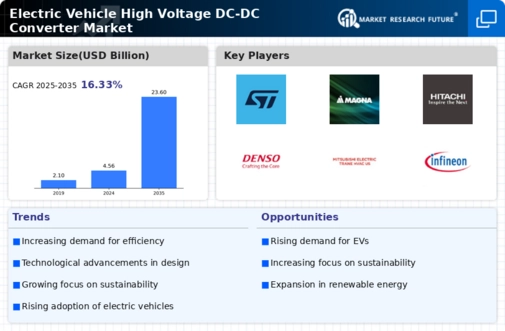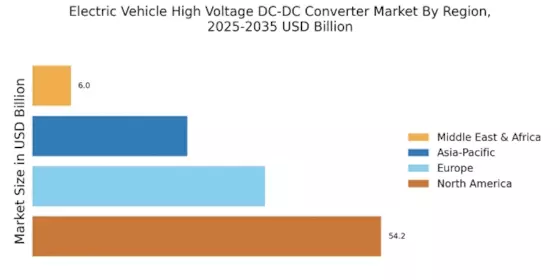Rising Focus on Energy Efficiency
The Electric Vehicle High Voltage DC-DC Converter Market is benefiting from a rising focus on energy efficiency within the automotive sector. As manufacturers strive to meet consumer expectations for longer driving ranges and lower energy consumption, the demand for high-efficiency DC-DC converters is increasing. These converters are essential for optimizing the energy flow between the battery and electric motor, thereby enhancing overall vehicle performance. Recent studies indicate that improvements in converter efficiency can lead to significant reductions in energy losses, which is crucial for maximizing the range of electric vehicles. This emphasis on energy efficiency aligns with broader sustainability goals, suggesting that the Electric Vehicle High Voltage DC-DC Converter Market will continue to grow as automakers prioritize the development of energy-efficient technologies.
Emerging Trends in Electric Vehicle Design
The Electric Vehicle High Voltage DC-DC Converter Market is also influenced by emerging trends in electric vehicle design. As manufacturers explore innovative vehicle architectures, such as modular and lightweight designs, the need for compact and efficient DC-DC converters becomes paramount. These design trends aim to enhance vehicle performance while reducing weight, which is critical for improving energy efficiency. Furthermore, the integration of advanced battery technologies, such as solid-state batteries, may require specialized DC-DC converters to manage higher voltage levels effectively. This evolving landscape suggests that the Electric Vehicle High Voltage DC-DC Converter Market will need to adapt to new design requirements, potentially leading to increased demand for innovative converter solutions that align with the latest automotive trends.
Increasing Electric Vehicle Adoption Rates
The Electric Vehicle High Voltage DC-DC Converter Market is poised for growth due to the increasing adoption rates of electric vehicles. As consumers become more environmentally conscious and governments implement stricter emissions regulations, the demand for electric vehicles is rising. According to recent data, electric vehicle sales have seen a substantial increase, with projections indicating that by 2025, electric vehicles could account for a significant percentage of total vehicle sales. This surge in electric vehicle adoption necessitates the development of efficient high voltage DC-DC converters to manage power distribution effectively. As automakers expand their electric vehicle offerings, the Electric Vehicle High Voltage DC-DC Converter Market is likely to benefit from this trend, as these converters play a crucial role in enhancing vehicle performance and energy efficiency.
Supportive Government Policies and Incentives
The Electric Vehicle High Voltage DC-DC Converter Market is significantly influenced by supportive government policies and incentives aimed at promoting electric vehicle adoption. Various countries are implementing tax credits, rebates, and subsidies to encourage consumers to purchase electric vehicles. Additionally, governments are investing in charging infrastructure, which is essential for the widespread adoption of electric vehicles. These initiatives not only stimulate demand for electric vehicles but also create a favorable environment for the Electric Vehicle High Voltage DC-DC Converter Market. As more electric vehicles hit the roads, the need for efficient DC-DC converters to manage power conversion will likely increase, driving market growth. The alignment of government policies with industry goals suggests a promising outlook for the Electric Vehicle High Voltage DC-DC Converter Market.
Technological Innovations in Power Electronics
The Electric Vehicle High Voltage DC-DC Converter Market is experiencing a surge in technological innovations, particularly in power electronics. Advancements in semiconductor materials, such as silicon carbide and gallium nitride, are enhancing the efficiency and performance of DC-DC converters. These materials allow for higher voltage operation and reduced energy losses, which are critical for electric vehicle applications. As manufacturers strive to improve the range and efficiency of electric vehicles, the demand for high-performance DC-DC converters is likely to increase. Furthermore, the integration of smart technologies, such as digital control systems, is enabling more precise management of power distribution, thereby optimizing the overall performance of electric vehicles. This trend suggests a robust growth trajectory for the Electric Vehicle High Voltage DC-DC Converter Market as it adapts to the evolving needs of the automotive sector.

















Leave a Comment